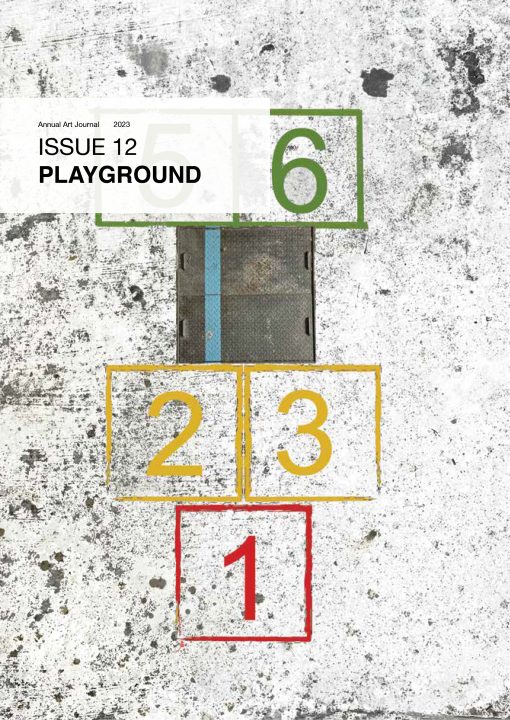The right to the city “manifests itself as a superior form of rights: the right to freedom, to individualization in socialization, to habitat and to inhabit”— Lefebvre*
The concept of having the right to places of encounter and exchange, to their life rhythms and time uses, enables the full agency of these moments and places. Within the following pages, I want to explore the idea of Playgrounds shaping multiple aspects of human experience. Playgrounds are gaining even more importance as zones of physical interaction in an increasingly digital world.
The notion of “play” is present in Henri Lefebvre’s concept of the right to the city, as the latter “stipulates the right to meetings and gatherings (…) the need for social life and a centre, the need and the function of play, the symbolic functions of space”. Drawing on this idea, this issue profiles artistic practices and specific works which create accessibility through playful engagement with complex topics and contemporary conflicts. These encounters can influence social, cultural, political, and economic perceptions. Some explore our desires by breaking down the narration of stories within an urban context, like Never Again by Monica Bonvicini, or Rules for the Expression of Architectural Desires by Debbie Ding; others engage with political struggles, like immigration and the experience of minorities reflected in Mr. Cuddle by Trevor Yeung or Moth (that Flies by Day) by Ong Si Hui. The rights of citizens to participate in decision-making processes can be seen in Superkilen by SUPERFLEX or Spiel-Skulptur / Play Sculpture by Regina Maria Möller, as they reflect on shared contemporary experiences.
Each of the works call for new epistemological approaches that look at art as the ever-changing outcome of a production process in which social and physical realities interact with mental ones, enabling a direct conversation with the work as (or through) “play”. Each work engages in a dismantling of their original intention, and therefore their reception becomes unscripted and challenges visitors to rethink their meaning. In some of the works, audiences are invited to claim agency and choose their own interpretations of the work, and the world, through playful engagement and interaction. The works presented here are intended to become constructive ways of un-learning and play, creating a dialogue within civil society and contributing to shaping individuals within a larger community. Changes in the perception of everyday life are what provides the impetus for major changes in society.
Monica Bonvicini
Monica Bonvicini (b. 1965, Italy) emerged as a visual artist and started exhibiting internationally in the mid-1990s. Her multifaceted practice investigates the relationship between architecture, power structures, gender and space. Her research is translated into works that question the meaning of making art, the ambiguity of language, and the limits and possibilities connected to the ideal of freedom. Dry-humoured, direct, and imbued with historical, political and social references, Bonvicini’s art never refrains from establishing a critical connection with the sites where it is exhibited, its materials, and the roles of spectator and creator. Since her first solo exhibition at the California Institute of the Arts in 1991, her approach has formally evolved over the years without betraying its analytical force and inclination to challenge the viewer’s perspective while taking hefty sideswipes at patriarchal, socio-cultural conventions.
Never Again
Monica Bonvicini began creating large-scale architectural installations in the 1990s exploring the built environment and how articulations of power and (sexual) identity define our construction of space. Never Again consists of a collection of swings composed from steel pipes, black leather and chains, suspended from a steel structure. The viewer navigates and physically engages with these subversive structures, all the while altering the politics of traditional exhibition viewing. Incorporating research on psychoanalysis, sexuality, labour, feminism, and architecture, the work of Bonvicini addresses how urban, private, and institutional spaces dictate our behaviour. As a societal and structural critique, Never Again comments on how minimalist art sanitised itself from the body.

Monica Bonvicini, Never Again, 2005.
Galvanised steel pipes, black leather, black leather men’s belts, galvanised chains, clamps. 350 x 1600 x 1100 cm.
Installation view at Hamburger Bahnhof, Berlin, 2005. Photo: Jens Ziehe. Courtesy the artist and VG-Bildkunst, Bonn.
Chang Wen-Hsuan
Chang Wen-hsuan (b. 1991, Taiwan) questions the narrative structure of institutionalised history with re-readings, re-writings, and suggestions of fictional alternatives in order to expose the power tensions embedded in historical narratives. Through versatile platforms including installations, videos, and lectures, Chang often navigates skewed documentations and first-person accounts to trigger reflections on how the understanding of history affects the purport of the present and thrust of the future. In 2018, she launched the project Writing FACTory. she is the recipient of several awards and prizes and has presented internationally.
Lecture Performance Syllabus
Lecture Performance Syllabus is a trilogy consisting of When Did the Merlion Become Extinct?—The Narrative to Succeed in the 21st Century (2019-2021); The Equipment Show (2021-2022); and The Ventriloquist (2021), which aims at exemplifying the interrelation between narration, performance, and the execution of power. In When Did the Merlion Become Extinct? —The Narrative to Succeed in the 21st Century, the artist delivers a lecture in a way reminiscent of a successology lecturer Victoria Chang, who defines the successology needed in the 21st century as the “National Narrative to Succeed” by breaking down the narratology into simple stories, affective stories, infectious stories, and democratic stories. While the first part of the trilogy examines the verbal language of authoritarian regimes, the second scrutinises the non-verbal communication of the strongman politics. The Equipment Show collects video clips including excerpts of historical figures, politicians, movie characters, and motivational speakers from YouTube, with the stage performer invited to deconstruct those gestures and also make a tutorial video, and “Victoria Chang” analysing the structural relationships between texts and the images. The last one, The Ventriloquist, deconstructs the narratology and performativity of the strongman by unveiling the technique of suture with the disclosure of dubbing. Combining video, installation, documents, and lecture performance, the trilogy probes into the governmentality of strongman, the designation of audienceship, and the unaccomplishment of democracy.

Chang Wen-Hsuan, When Did the Merlion Become Extinct?—The Narrative to Succeed in the 21st Century. 2019-2020.
Photo: Bat Planet Photography. Courtesy Taiwan Contemporary Culture Lab (C-LAB).
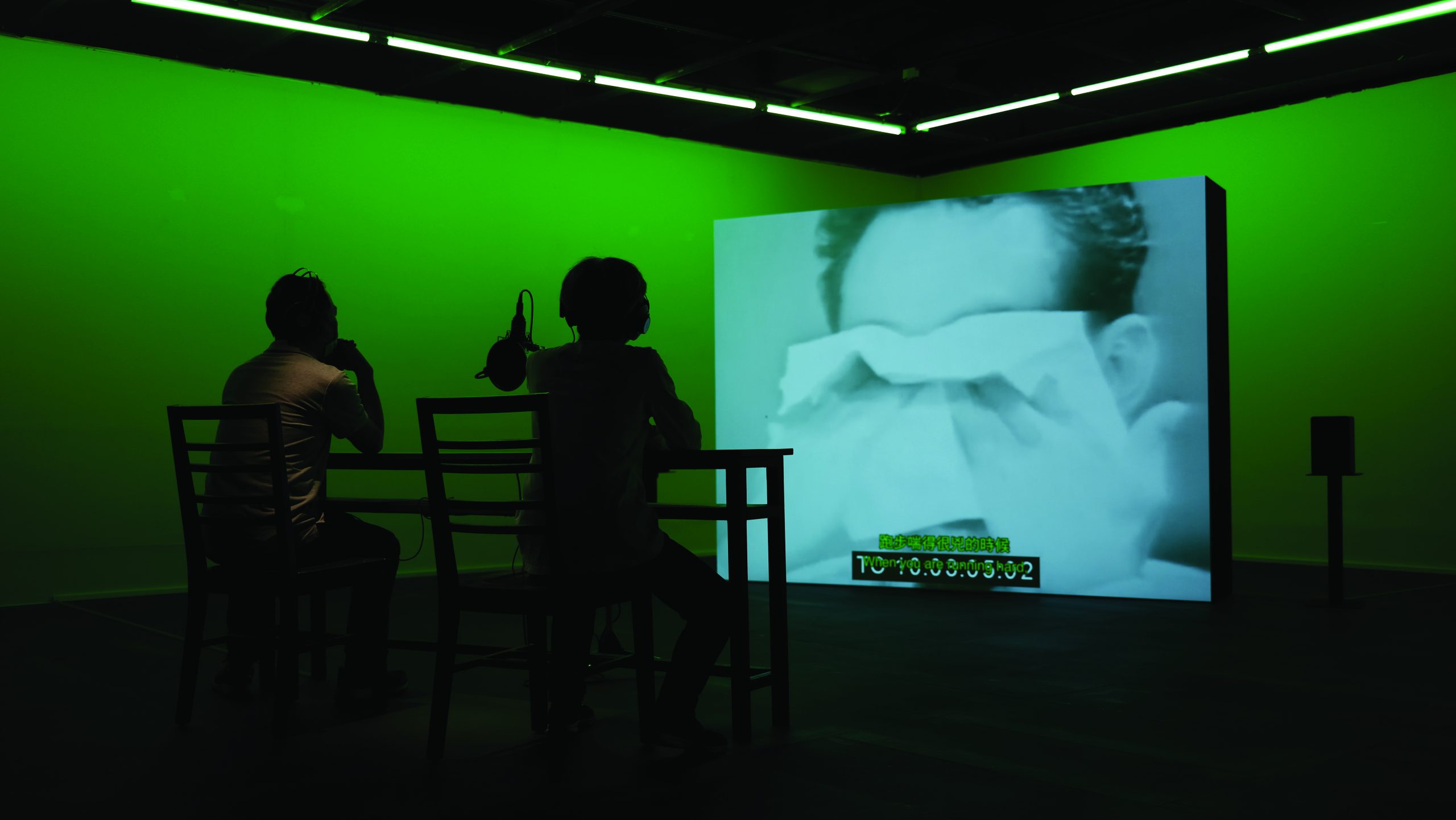
Chang Wen-Hsuan, The Ventriloquist. 2021.
Installation view, Lecture Performance Syllabus: Chang Wen-Hsuan solo Exhibition, Kuandu Museum of Fine Arts. 2021.
Courtesy the artist.

Chang Wen-Hsuan, The Equipment Show. 2022.
Installation view, Making Worlds: An Imagineering Project, Museum of Contemporary Art Taipei, 2022.
Photo: ANPIS FOTO, Anipis Wang. Courtesy The Museum of Contemporary Art, Taipei.
Kray Chen
Kray Chen (b. 1987, Singapore) is a visual artist dealing with film, performance and installations. Kray is fascinated with social rituals where he often finds the peculiar or absurd to look at the gaps between what we imagine and what we find in real-life. He has presented internationally and is the recipient of the 2017 National Arts Council’s Young Artist Award.
Waiting for the Bird #1 and #2
In the Waiting for the Bird series, the sculptures condense the dimensions of Mahjong, figuratively and metaphorically, into a tight-fitting diorama that are inspired by the dramatic depictions of legendary Mahjong gameplays in Hong Kong films. Chen recreates the scenarios where each player, although gifted with legendary winning hands, are stuck in an impasse where everyone waits for the last Bird tile.

Kray Chen, Waiting for the Bird #1 (lightwood), 2018 and Waiting for the Bird #2 (darkwood), 2019.
Collected Mahjong tiles, wood, fabric. Installation view IN RANDOM, 23 January – 3 March 2019, Fost Gallery, Singapore.
Courtesy the artist and Fost Gallery.
Heman Chong
Heman Chong (b. 1977, Malaysia, raised in Singapore) is an artist whose work is located at the intersection between image, performance, situations and writing. His practice can be read as an imagining, interrogation and sometimes intervention into infrastructure as an everyday medium of politics. His work has been the subject of solo exhibitions at many international Institutions. Chong is the co-director and founder (with Renée Staal) of The Library of Unread Books, a library made up of donated books previously unread by their owners.
God Bless Diana
A series of images collected in a rigorous manner over five years and totalling around 6,000, which have been edited down to a set of 550. Displayed as a postcard shop, the work reflects on the process of collecting. Of interest to Chong is the process of accumulation that very immediately slips into the dissemination of an archive, and how this archive becomes open to its availability. The idea that people curate their own viewing experiences, rather than having somebody else define these, is an important aspect to the artist. When buying the postcards, people need to go through the selection process and create their own ways of seeing. This archive is an early work by Heman Chong when he was at the very beginning of his artistic practice. It encapsulates themes that later resurface in his works, like collectivity, monumentalisation, objects, displaced systems, performativity, time, art history, and death.
This project was initially commissioned for the Kröller-Müller Museum in the Netherlands.
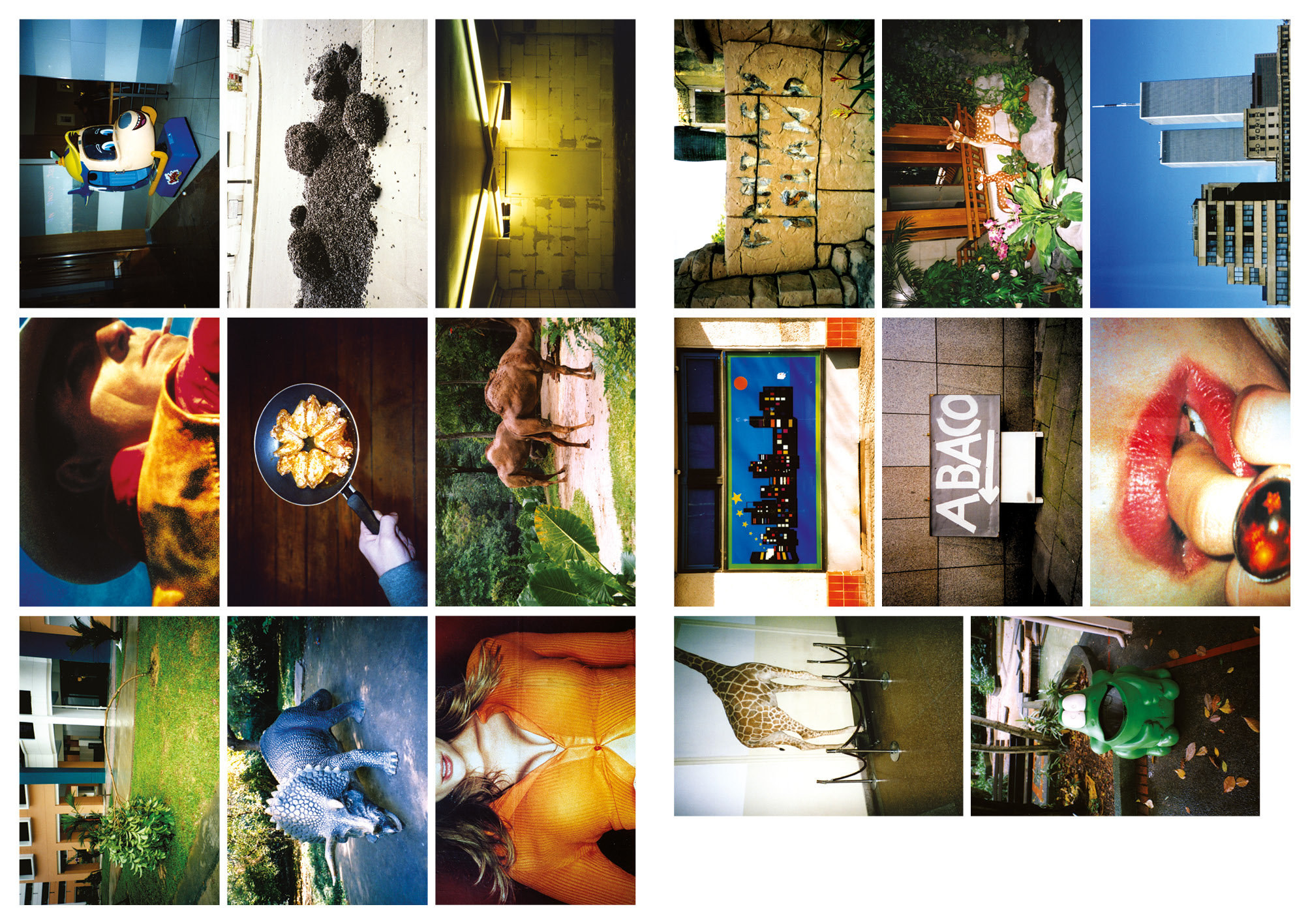
Heman Chong, God Bless Diana, 2000-2004.
17 / 550 postcards. Dimensions variable. Courtesy the artist and Amanda Wilkinson Gallery.
Debbie Ding
Debbie Ding (b.1984, Singapore) is a visual artist and technologist whose interests range from historical research and urban geography to visions of the future. She reworks and re-appropriates formal, qualitative approaches to collecting, labelling, organising, and interpreting assemblages of information – using this to open up possibilities for alternative constructions of knowledge. Using interactive computer simulations, rapid prototyping, and other visual technologies, she creates works about subjects such as map traps, lost islands (Pulau Saigon), World War II histories, soil, bomb shelters, and public housing void decks.
Rules for the Expression of Architectural Desires
The design of our built environment begins with ideas, often articulated in a manner that may be conceptual, abstract, or even imprecise. Even though the city is built with concrete and glass, when we explore its textures we find that its core is made up of ideas, desires and emotions. In order for us to imagine new cities and solutions, we need to re-write the rules.
Rules for the Expression of Architectural Desires is made up of 24 speculative schemes, devices and instruments for the urban and social re-design of a city. Each of these rules is written with the intention of promoting the expression of architectural desires, although it is unclear whether they will change the city for better or worse. You decide.
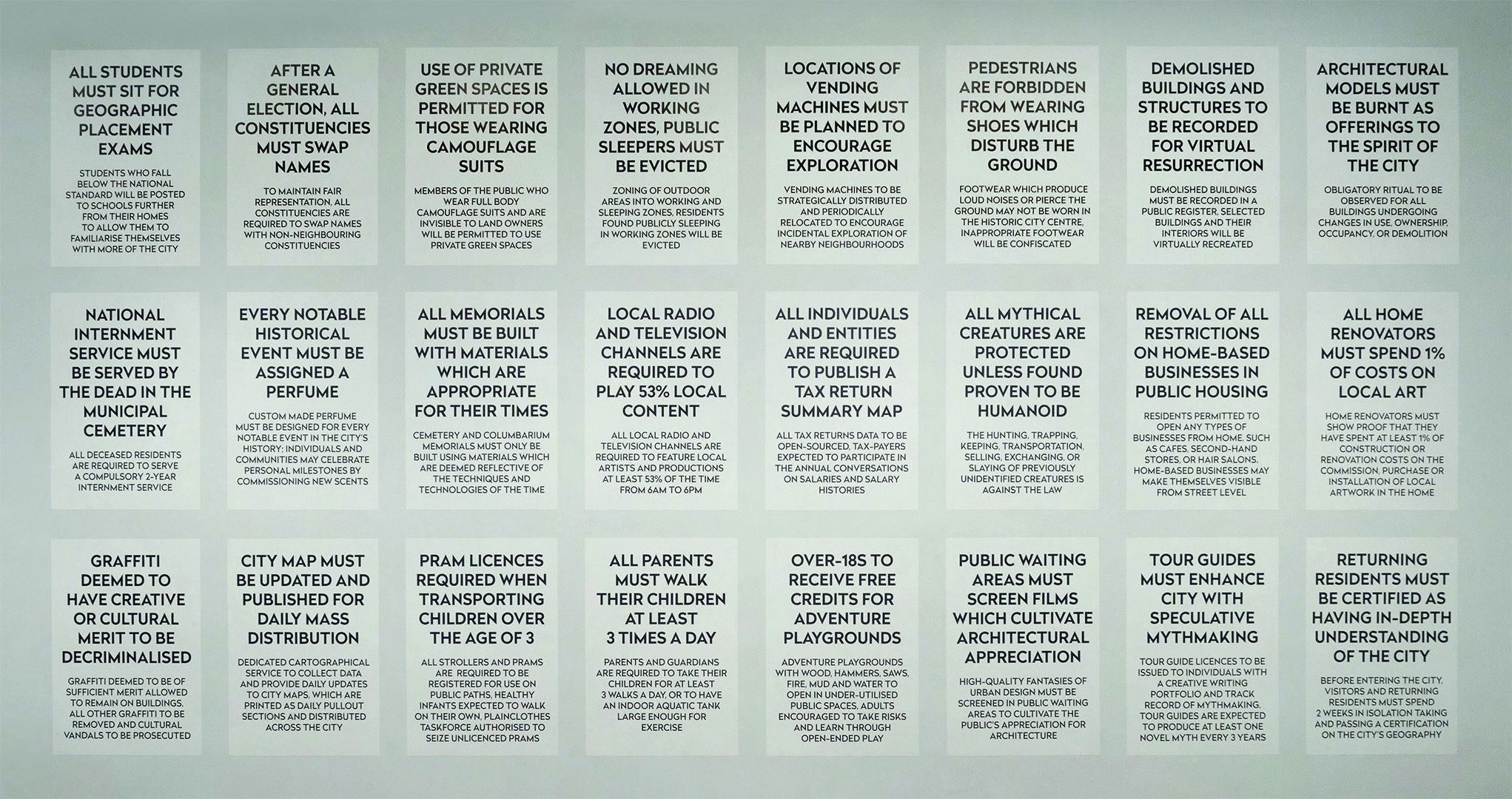
Debbie Ding, Rules for the Expression of Architectural Desires, 2014-2021.
24 UV printed posters on newsprint paper. Installation view Wikicliki: Collecting Habits on an Earth Filled with Smartphones,
22 April–11 July 2021, Singapore Art Museum. Photo: the artist.
Anne Duk Hee Jordan
Anne Duk Hee Jordan (b. 1978, Korea) Korean-German artist, whose background shaped her interests in art, science, and philosophy. Her work often speaks of issues of migration, identity, and social spaces, using natural or biological processes as metaphors. Her installations are meticulously researched and she often uses humour to get her point across. She uses both living and dead materials, at times constructing machines that can mirror organisms to create a dialogue between art and science, her identity, and social systems.
Making Kin
How do we want to live in the future? In a combination of various media such as living plants, installation, drawings, and robotics, Anne Duk Hee Jordan, explores concepts of interspecies community and real and fictional landscapes. “Making Kin” is a maxim coined by the philosopher of science and pioneer cyborg feminist Donna Haraway who calls for an interspecies symbiosis. To ensure a liveable future for the following generations, we, as mortal “critters”, need to link up with multiple configurations of places, times, matters and meanings so that new life can be “composted” from the planet-destroying Homo sapiens. Jordan scrutinises established terms like nature, culture, and technology, including their definitional boundaries. The artist is interested in the hybrid network between species and their environment. In a humorous and playful manner, she draws up an experimental and future-oriented scenario that challenges our customary perspectives on life and, likewise, makes a new model of community both imaginable and apprehensible. The work Water Crab (2017– ongoing) is conceived to function as a marine robotic. As her Artificial Stupidity series is about allowing failure and reclaiming the domain of robotics in terms of non-intelligence, this Water Crab is not able to clean up all the human waste in the oceans, but is rather a prototype of this idea and advocation that design or art is not only there to make the world a better place. Does a non-functional artificial bot also have the right to float in our waters?
This work was conceived for the exhibition “Making Kin” at the Kunsthaus Hamburg, Germany, curated by Anna Nowak.
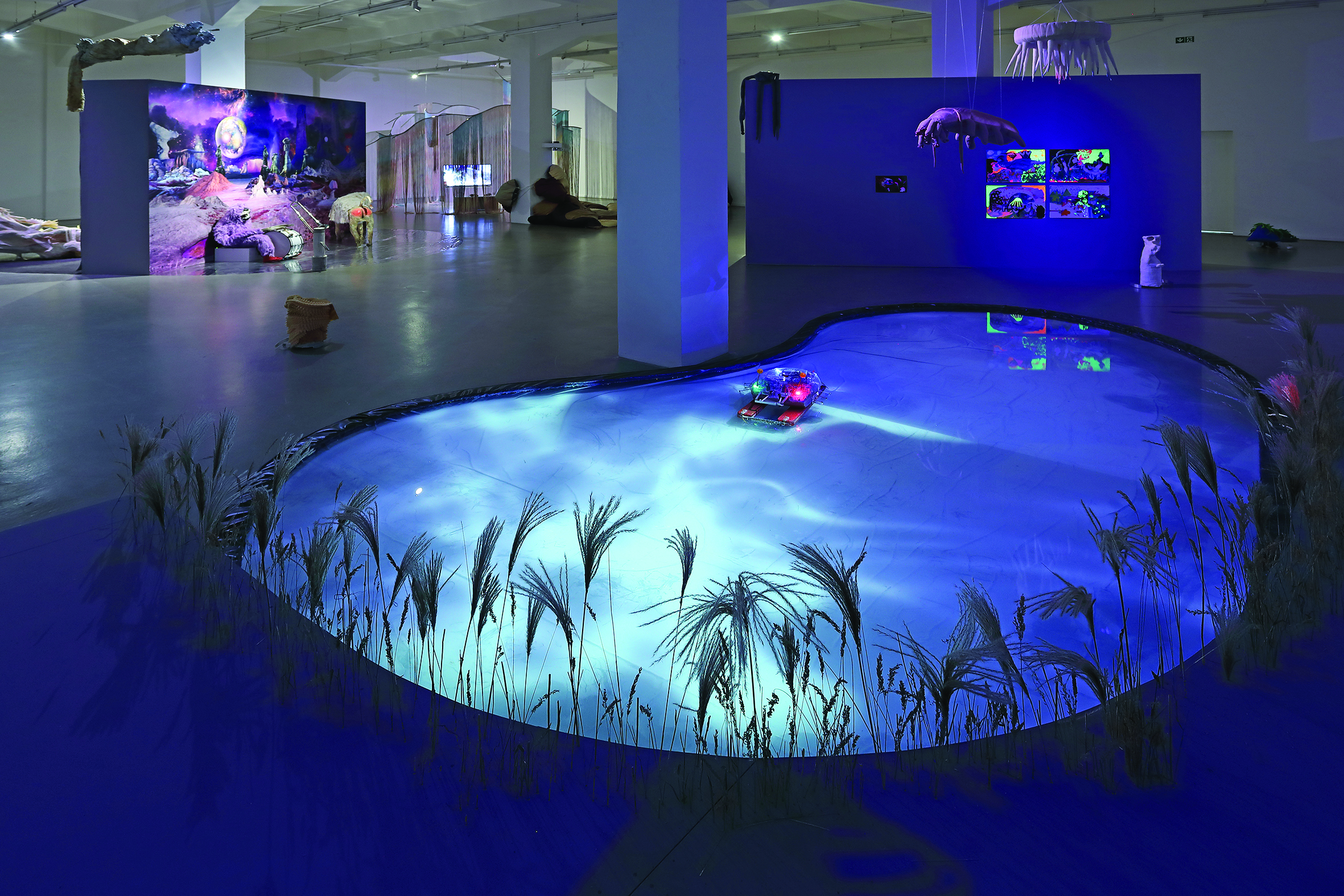
Anne Duk Hee Jordan, Making Kin, 2020
Site-specific artificial pond with artificial crab and 2 channel video, along with critters, sea animal sculptures and
drawing. Installation view Making Kin. 3 July – 6 September 2020, Kunsthaus Hamburg. Courtesy the artist.
Valentina Karga
Valentina Karga (b. 1986, Greece) is currently working on challenging the notion of ‘self’ by proposing non-anthropocentric future narratives. A large part of her projects encourage engagement and participation, facilitate practices of commoning and are concerned with sustainability. She works across different media, often inviting a public or a community to literally complete the work. Sometimes, through dialogue and building prototypes in a DIY manner, they end up imagining alternatives for infrastructures and institutions that structure our reality. This is what she calls ‘Art as Simulation’. She is a founding member of Collective Disaster, an interdisciplinary group that works in the interstices of architecture and the social realm.
Well Beings
In the exhibition Well Beings at the MK&G (Museum für Kunst und Gewerbe Hamburg), artist, architect and designer Valentina Karga deals with the fears triggered by ecological crises. Based on her own experience with such anxieties, she has developed an interactive parkour that invites visitors to try out for themselves various exhibits inspired by popular self-care objects. These include hug-pillows and weighted blankets as well as oversized plush toys that are blown-up versions of small figurines from the museum’s Antiquities Collection.
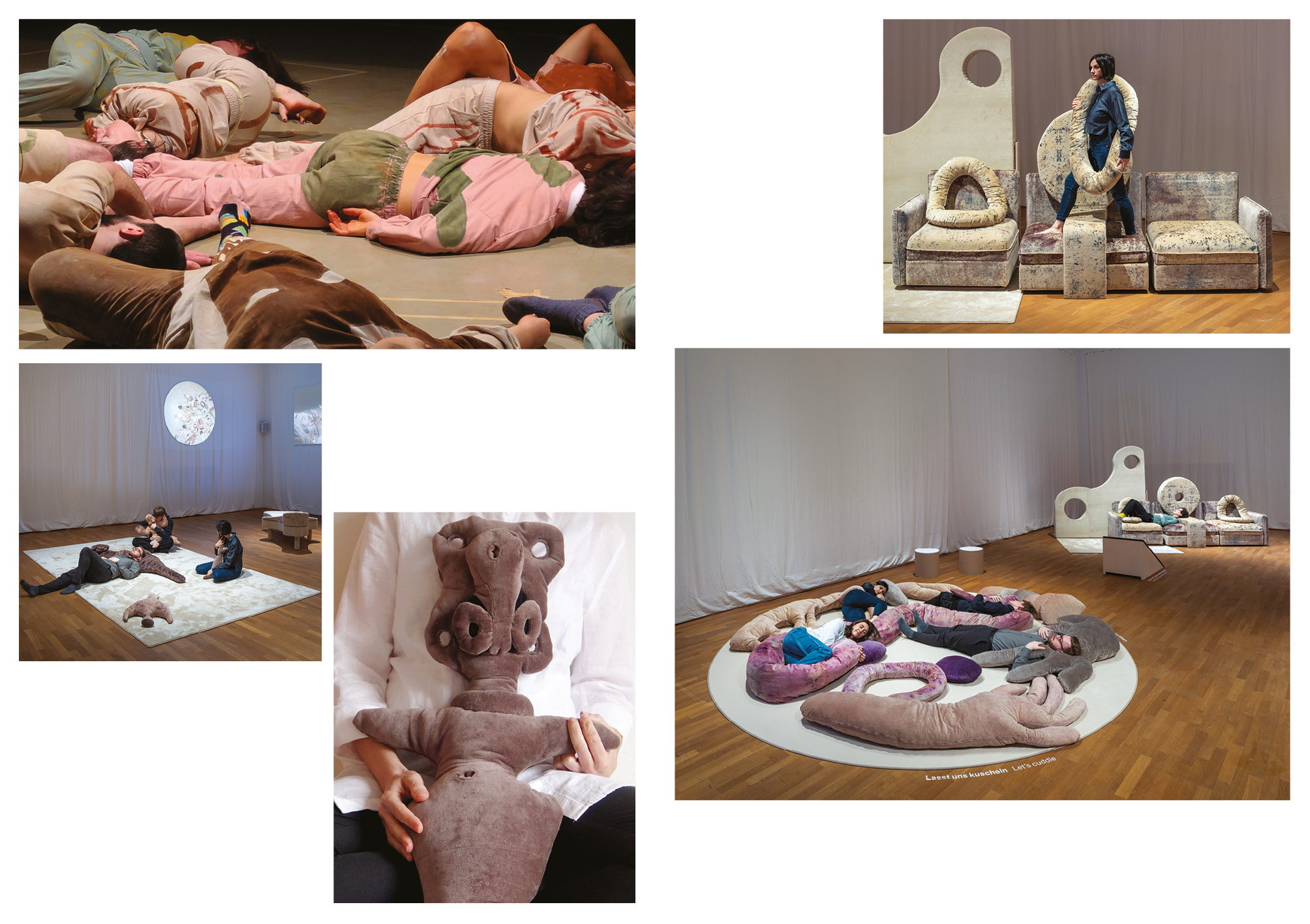
Valentina Karga, Well Beings, 2023.
Upholstery, natural and recycled materials, natural dyes, HD video, sound. Installation view, Valentina Karga: Well Beings, 24
March–3 September 2023, Museum für Kunst und Gewerbe, Hamburg. Courtesy the artist.
Lai Yu Tong
Lai Yu Tong (b. 1996, Singapore) is a visual artist whose works span across image-making, painting, drawing and installation. He makes works about the things he sees, things he eats, things he buys, things he throws away, and more, examining habits of consumption in the modern world.
Rearrange The World
Rearrange The World is a series of 30 paper-cut collages that depicts a game being played between two hands, one of which bears a bandage around its thumb. Three objects—a cup, a can, and a bottle—are moved about on a table, tumbling, balancing, rolling and overturning around one another, forming new configurations at each turn. The words ascribed to the objects are a combination from common vocabulary taught to children and words that the artist hopes to teach to children. The work reflects on the possibility of changing the world by rearranging it.
A version of this work will be produced into a children’s book, published by Thumb Books, a small press founded by the artist in 2022 that makes children’s books for both children and adults.

Lai Yu Tong, Rearrange the World, 2023.
15 / 30 paper-cut collages.
Graphite, copier-paper, recycled paper. Courtesy the artist.
Regina Maria Möller
Regina Maria Möller (b.1962, Germany) is the founder of the magazine regina and creator of the label embodiment. Her artistic practice is conceptual and involves a wide range of media formats; interweaving complex stories, which deal with, for example, the question of identities, the physical body’s presence in digital times, and the environment at large. When the Corona pandemic broke out in March 2020 Möller worked together with historians from science, technology, medicine and the environment on the research project The Mask – Arrayed, hosted by the Max Planck Institute for the History of Science (MPIWG). The projects and works of Regina Maria Möller have been exhibited nationally and internationally.
Spiel-Skulptur / Play Sculpture
Since her early career, Möller’s interest lays in producing artworks that could be used or worn to challenge the social capacities of the aloof. With Play Sculpture, an ‘Art in Public Space’ for a kindergarden in Großmugl, Germany, she created a sculpture that doubles as a playground. The climbing structure is based on children’s drawings, and the rectangular box on top of the climbing frame represents a moving cardboard box. Children can access the box from entrances on two sides, one round and the other square. Both openings are framed by a graphic drawing of an open box, creating a ‘trompe-l’oeil’ effect from a distance. The interior of the box is covered with green chalkboard paint so that children can constantly redesign their four walls without being observed by their parents or kindergarten teachers. On the closed sides of the moving box, the words ‘children’s room’ or ‘living room’ can be read in six different languages, referring to Austria’s neighbouring countries and vast international communities.
Großmugl’s Cat
Years later at the same kindergarden in Großmugl, Möller developed a second public art project doubling as playground: Großmugl’s Cat. The name of the town is derived from a large Bronze Age burial mound nearby. Möller invokes this historical site by creating a small hill alongside a large cat sculpture. An opening in the mound serves as a tunnel through which children can escape the lurking cat, which also functions as a climbing wall. The work embodies an ethic of work and play, consistent with the motto of Charles and Ray Eames, “We must take the game seriously.”

Regina Maria Möller, Großmugl’s Cat, 2011.
Installation view Kindergarten Großmugl, Photo: Regina Maria Möller. Courtesy the artist and Niederösterreichische
Landesausstellung, Abt Kunst und Kultur / Kunst im öffentlichen Raum / Marktgemeinde Großmugl.

Drawing by Thomas Möller, Großmugl’s Cat and Play Sculpture, 2011.
Courtesy the artist and VG Bild-Kunst Bonn.

Regina Maria Möller, Spiel-Skulptur / Play Sculpture, 2001,
Installation view Kindergarten Großmugl. Photo: Werner Kaligofsky. Courtesy the
artist and Niederösterreichische Landesausstellung, Abt Kunst und Kultur / Kunst
im öffentlichen Raum / Marktgemeinde Großmugl

Regina Maria Möller, mousehole / Großmugl’s Cat, 2011.
Detail. Courtesy the artist and VG Bild-Kunst Bonn.
Ong Si Hui
Ong Si Hui (b. 1993, Singapore) is a visual artist based in Singapore. She is a trained sculptor from the Nanyang Academy of Fine Arts and LASALLE College of the Arts, Singapore. Working extensively in stone, she explores the spirit of the medium through slow and meticulous hand carving processes. She addresses materiality, human conditions, fragility, anxiety, and reflects upon the behaviour of a work story. Her geometric forms and text-oriented works are often manifestations of her stream of consciousness.
Moth (that flies by day)
In late 2017, the area where the artist lived was overpopulated with moths; Ong became intrigued by both their boundless energy and complete stillness, that at times happened all at once. The daily scene also reminded the artist of Virginia Woolf’s essay The Death of the Moth, where she described with great dignity a moth’s death.
Thinking about the death of moths, and how their bodies are sometimes fastened down as specimens, stripped of life, Ong wanted to embody their spirit in stone, a medium that instead bears the history of time. This series began as an exploration of energy that lies within dormant forms.
Each form takes after different phases of the moth’s life and is illustrated in its physical qualities. Motions suspended in delicate fashion, with tilted axis, wander forward and backward through a meandering path. Each piece from the series represents the motions or spirit of the moth in different ways, and altogether, it reflects upon the complexity of the short life of a moth.
Through the narrative of the moth, a series of 7 pieces1, relate to the artist’s personal anxiety. Ong experiments with the delicacy of the forms, the brittleness of the marble, and their vulnerability to external movements, all the while containing tremendous amounts of nervous energy within.
1 artwork information of individual pieces: https://www.ongsihui.com/moththatfliesbyday
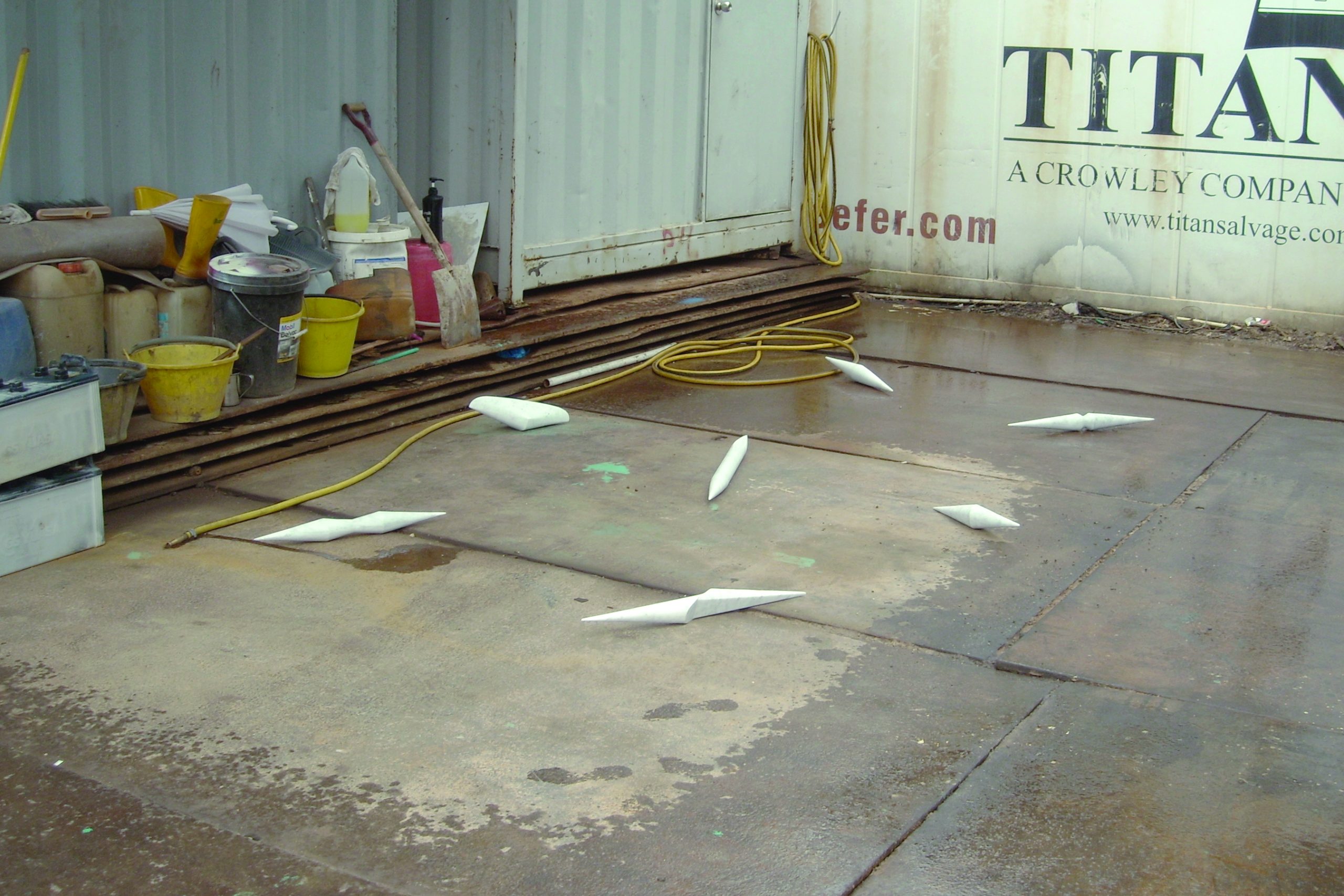
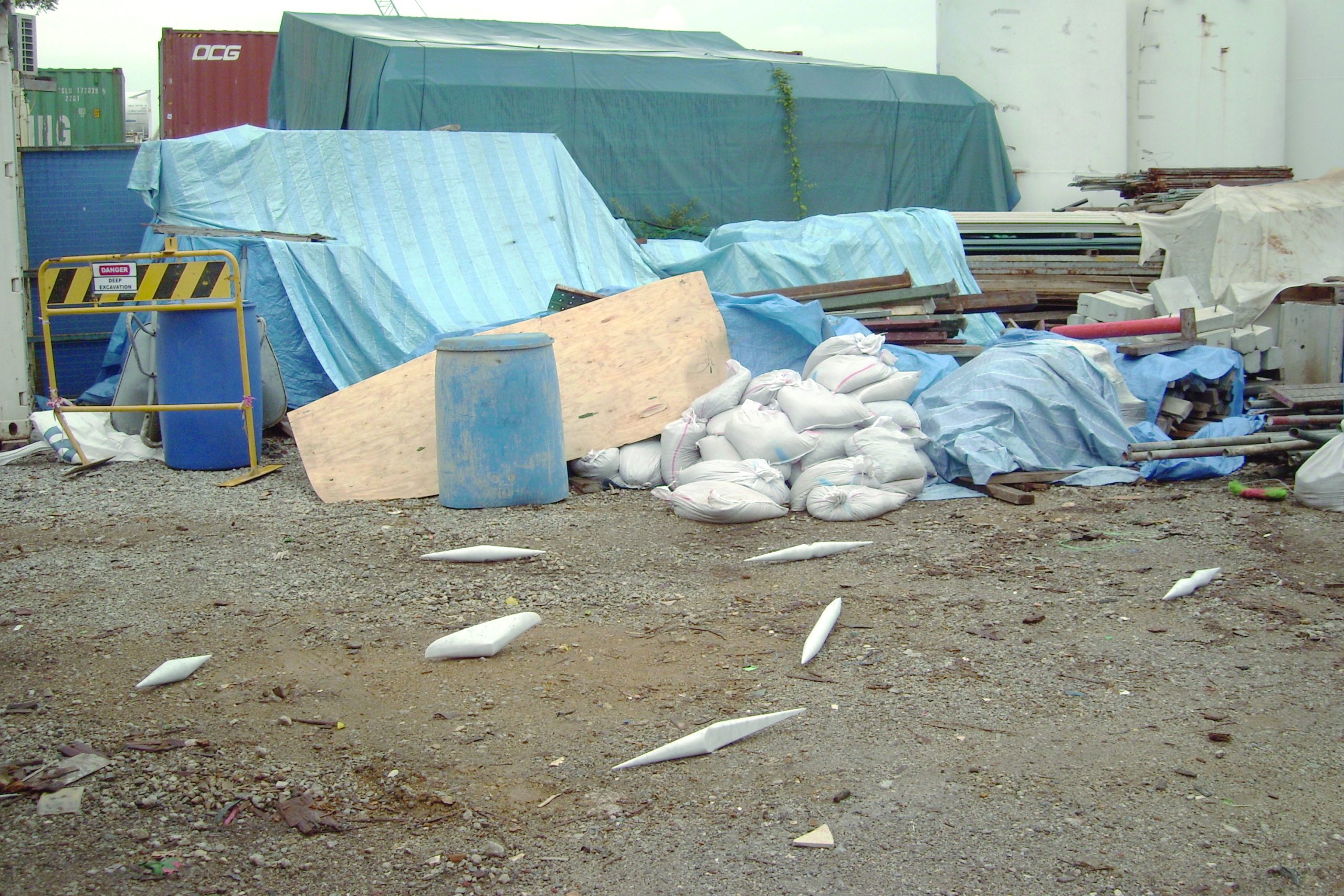

Ong Si Hui, Moth (that flies by day), 2018.
Marble, series of 7. Dimensions variable. Courtesy the artist.
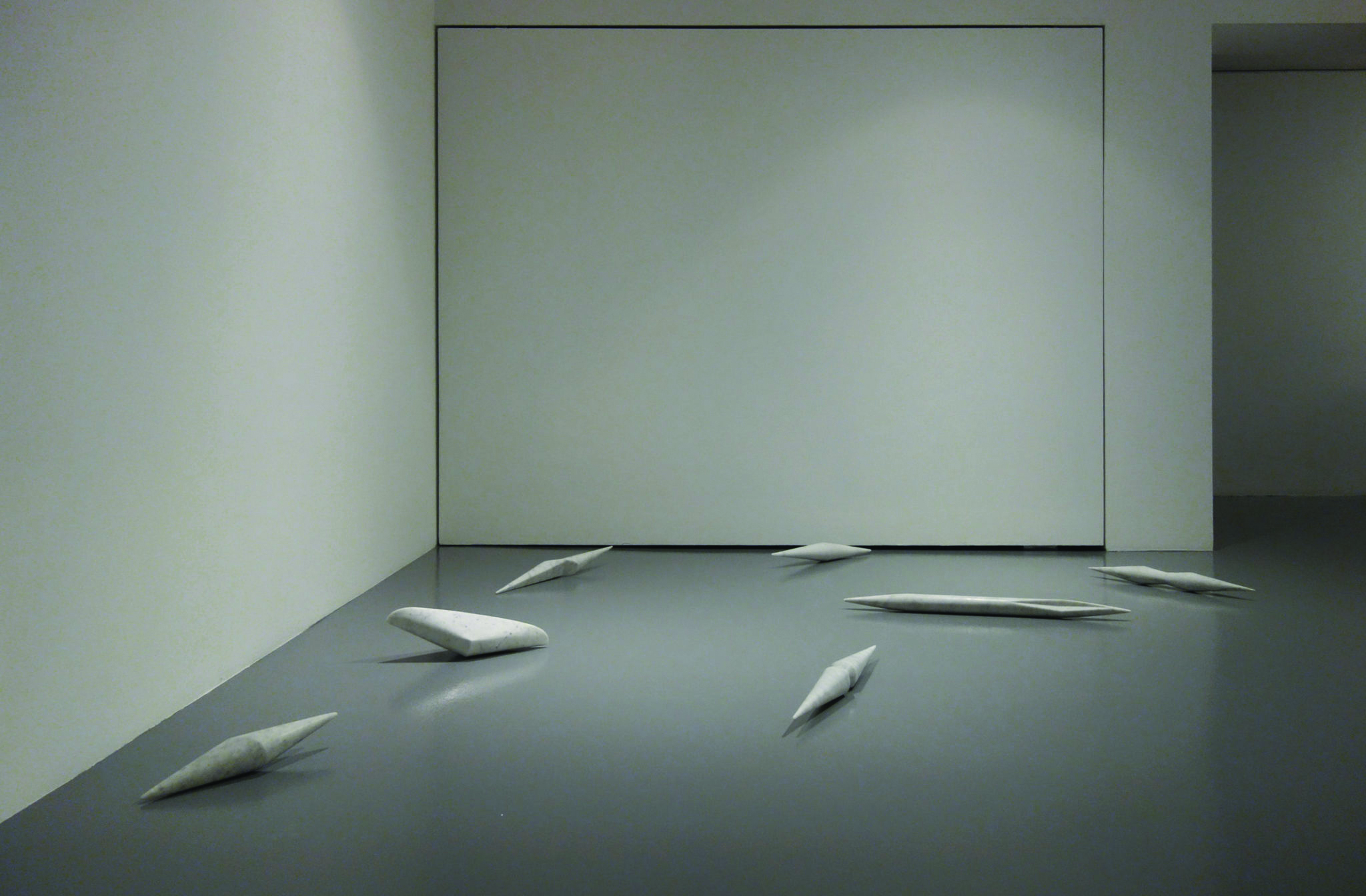
Ong Si Hui, Moth (that flies by day). 2018.
Marble. Dimensions variable. Installation view, The Lie of the Land, 07 August–17 October 2021, Fost Gallery.
Courtesy the artist and FOST Gallery.
Marjetica Potrč
Marjetica Potrč (b.1953, Slovenia) is an artist and architect based in Ljubljana. From 2011 to 2018, she was a professor of social practice at the University of Fine Arts/HFBK in Hamburg, where she taught Design for the Living World, a class on participatory practices. She has also been a visiting professor at a number of other institutions, including the Massachusetts Institute of Technology (2005) and the IUAV Faculty of Arts and Design in Venice (2008, 2010). Potrč has received numerous awards, grants, fellowships, and residencies. Her work has been exhibited extensively throughout Europe and the Americas.
Notes on Participatory Design, no. 7, 2014
Art depends on culture and is a tool to change culture itself. When art is a relational object, it mediates our relationship to the world and the artist becomes a mediator.

Marjetica Potrč, Notes on Participatory Design, no. 7, 2014.
Ink on paper. 21 x 29.7 cm. Courtesy the artist and Galerie Nordenhake, Berlin/Stockholm/Mexico City.
SUPERFLEX
SUPERFLEX was founded in 1993 by Jakob Fenger, Bjørnstjerne Christiansen, and Rasmus Rosengren Nielsen. Conceived as an expanded collective, SUPERFLEX has consistently worked with a wide variety of collaborators, from gardeners to engineers to audience members. Engaging with alternative models for the creation of social and economic organisation, works have taken the form of energy systems, beverages, sculptures, copies, hypnosis sessions, infrastructure, paintings, plant nurseries, contracts, and public spaces. Working in and outside the physical location of the exhibition space, SUPERFLEX has been engaged in major public space projects since their award-winning project Superkilen opened in 2011. These projects often involve participation and the input of local communities, specialists, and children. Taking the idea of collaboration even further, recent works have involved soliciting the participation of other species. SUPERFLEX has been developing a new kind of urbanism that includes the perspectives of plants and animals, aiming to move society towards interspecies living. For SUPERFLEX, the best idea might come from a fish.
Superkilen
Interview with SUPERFLEX about the work:
Uploaded on https://youtu.be/rlCo4Mg3Rdk

Superkilen is a public space in Copenhagen divided into three main areas: The Red Square, The Black Square and The Green Park. The Red Square represents modern urban life with a café, music and sports, while The Black Square is a classic square with fountains and benches and The Green Park is a park for picnics, sports and walking dogs.
The people living in the immediate vicinity of the park represent more than 50 different nationalities. Instead of including the city objects usually designated for parks and public spaces, SUPERFLEX asked people from the area to nominate objects such as benches, bins, trees, playgrounds, manhole covers and signage from other countries. These objects were chosen either from the country of the relevant inhabitant’s national origin, or from somewhere else encountered through traveling. The objects were either produced in a one to one scale copy or bought and transported to the site.
Furthermore, as part of a process that SUPERFLEX calls ‘extreme participation’, five groups travelled with SUPERFLEX to Palestine, Spain, Thailand, Texas and Jamaica in order to acquire five objects of their choice. These have since been installed in the park. In total, the park now contains more than 100 different objects from more than 50 different countries.
Superkilen was designed in collaboration with BIG and Topotek1. Commissioned by the City of Copenhagen and Realdania, Denmark.
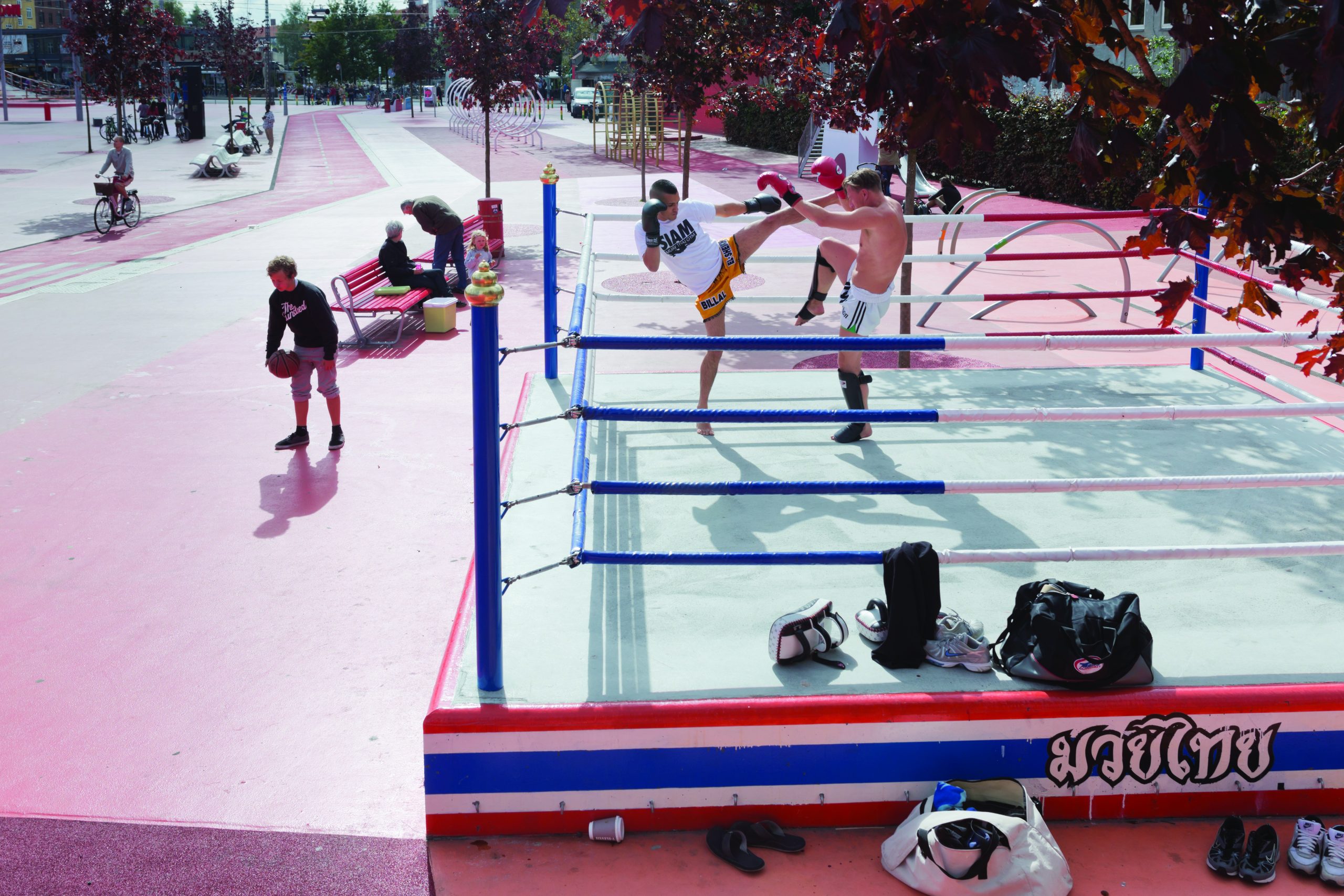
Superkilen, 2012. Red Square. Photo: Iwan Baan.

Superkilen, 2012. Red Square.
Photo: Torben Eskerod.

Superkilen, 2012. Red Square.
Photo: Torben Eskerod.

Superkilen, 2012. Red Square, Thai boxing.
Photo: Iwan Baan.
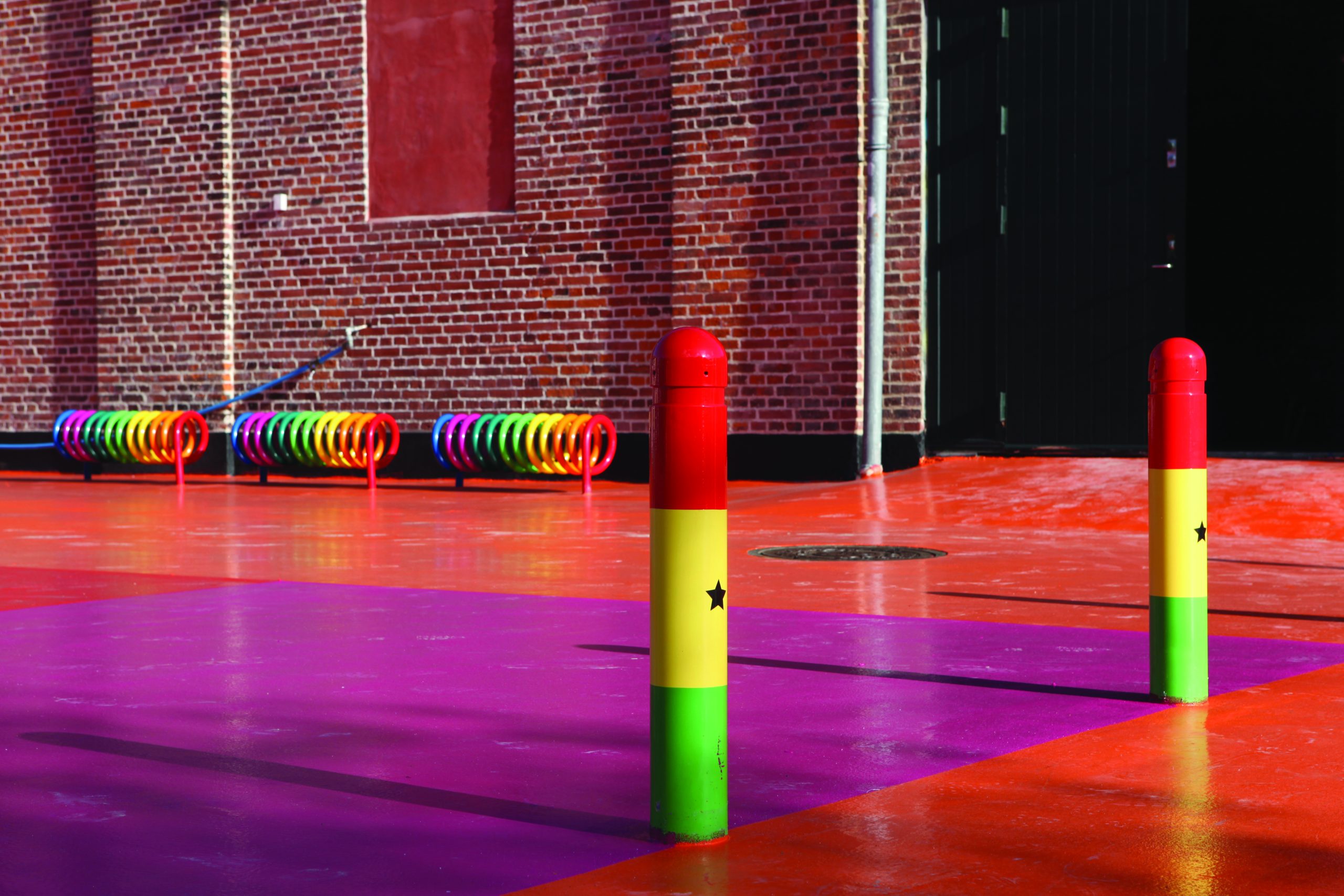
Superkilen, 2012. Red Square.
Photo: SUPERFLEX.
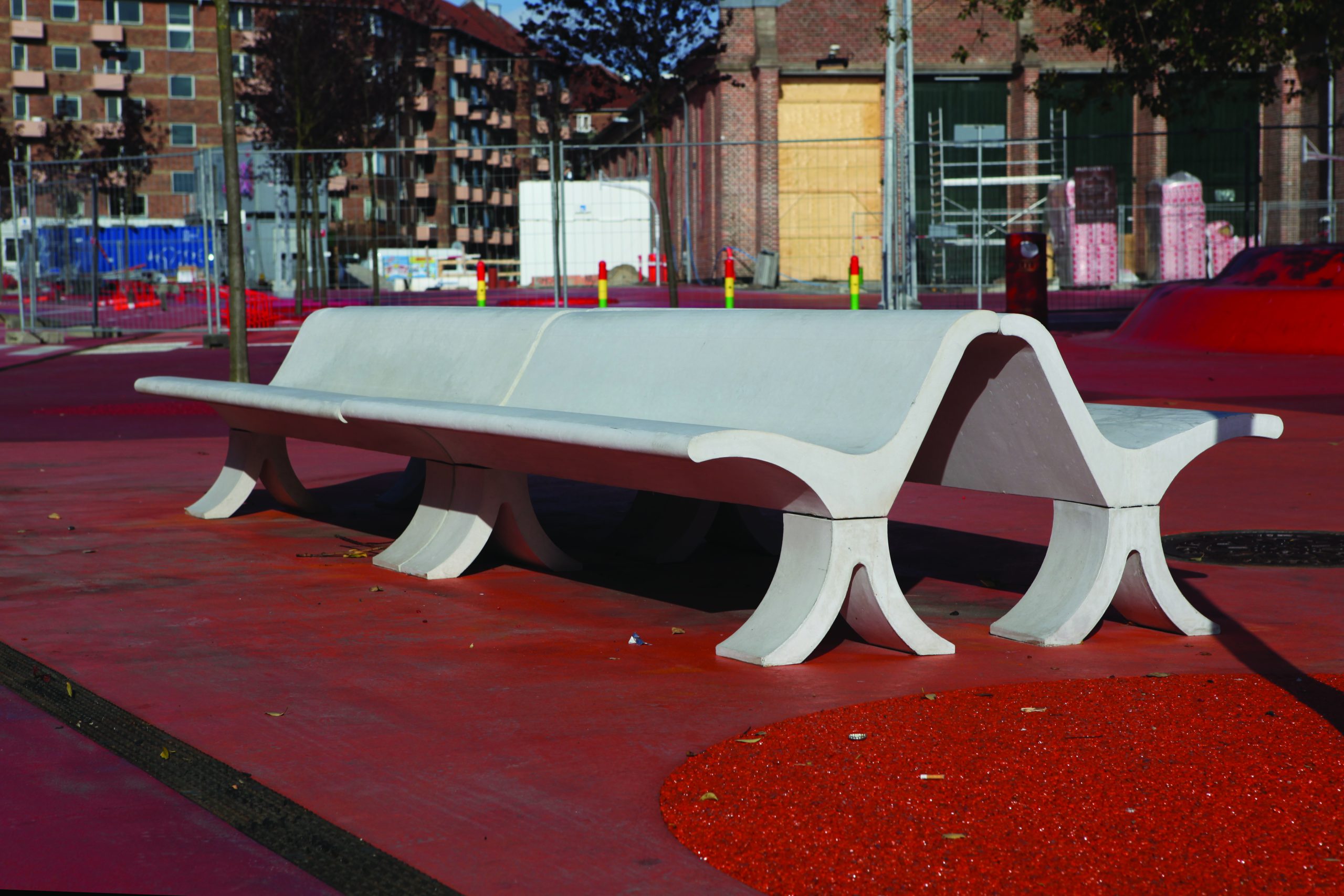
Superkilen, 2012. Red Square, Bench from Salvador, Brazil.
Photo: SUPERFLEX.
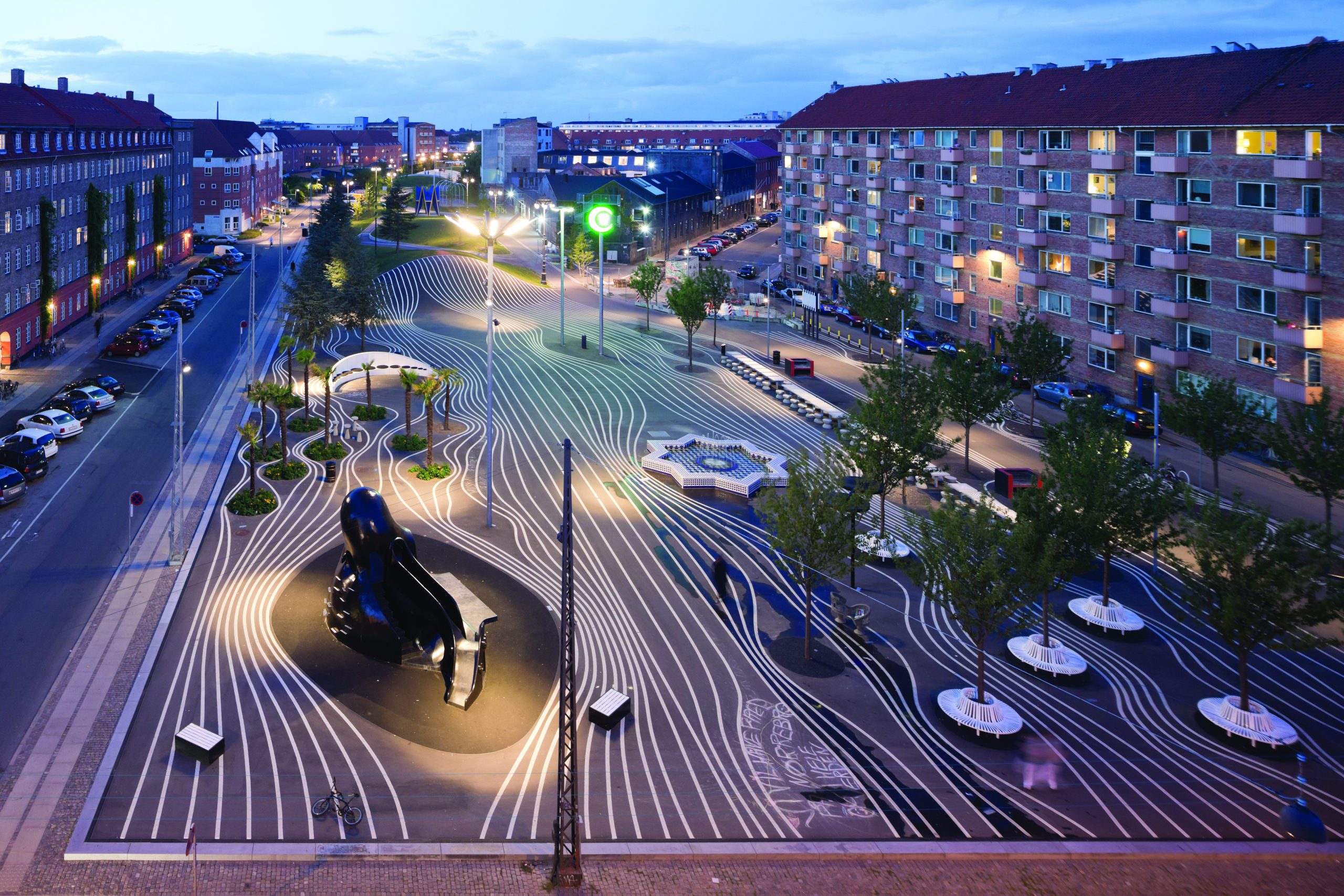
Superkilen, 2012. Black Square.
Photo: Iwan Baan.

Superkilen, 2012. Black Square, Octopus.
Photo: Torben Eskerod.
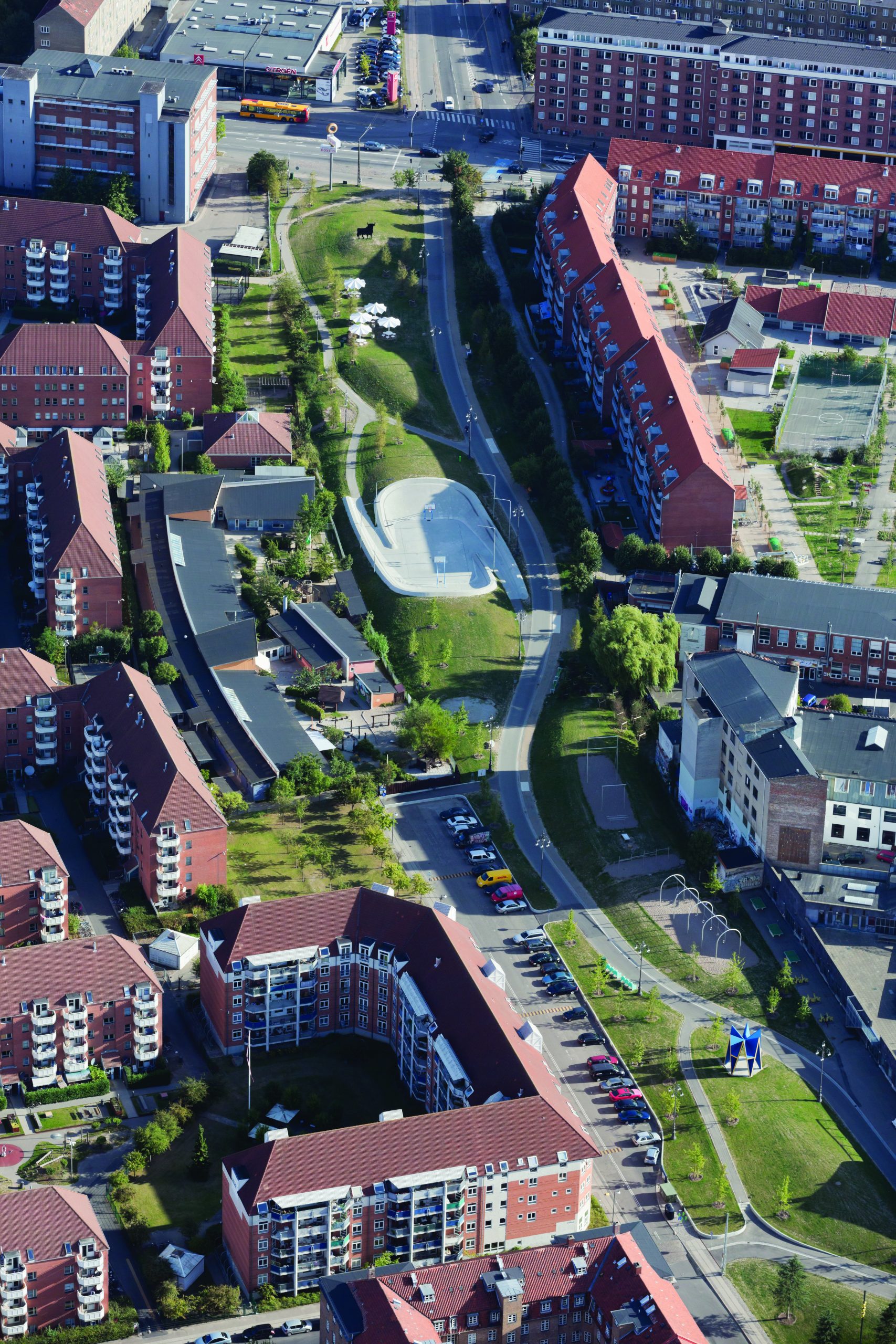
Superkilen, 2012. Green Park.
Photo: Iwan Baan.

Superkilen, 2012. Green Park.
Photo: Jens Lindhe.
All images Superkilen, 2012. Urban park in Copenhagen. Commissioned by City of Copenhagen and RealDania.
Developed in close collaboration with Bjarke Ingels Group (BIG) and Topotek1. Courtesy SUPERFLEX.
Berny Tan
Berny Tan (b.1990, Singapore) is an artist, curator, and writer working in Singapore. Her interdisciplinary practice explores the tensions that arise when she applies systems to – and unearths systems in – her subjective experiences. Tan’s strategies also reflect a fundamental interest in language as it is read, written, and spoken by her. As an independent curator, she has developed approaches built on principles of empathy, sensitivity, and collaboration.In 2022, she was awarded the IMPART Art Prize in the curator category.
Page Break
Page Break was a three-month Curatorial and Research Residency at the Singapore Art Museum, presented as part of the Singapore Biennale 2022, named Natasha. As a project, it looked at how everyday objects and scenes are explored through the medium of the art book, particularly within the context of Singapore.
While residencies tend to be insular frameworks for research, Page Break instead allowed the public access to an open studio that hosted Tan’s personal workspace, an exhibition space, an art book library, and occasional programmes. The exhibition evolved over four ‘drafts’, incrementally incorporating book projects by Atelier HOKO, Catherine Hu, Chua Chye Teck and Liu Liling, Genevieve Leong, Lai Yu Tong, and Marvin Tang. The residency thus functioned as a site for collaborations that built on Tan’s existing connections within the visual art community in Singapore, bringing together artists and designers who make art books that examine the otherwise ordinary.
Extending the material exploration of the print medium, waste from print production was repurposed to create partitions and modular furniture which served as either seating or display surfaces. These structures were designed by art director Pixie Tan with support from Sean Gwee of fabrication collective Made Agency. At the conclusion of Page Break, the materials were returned to the recycling process, minimising the waste generated by the project.
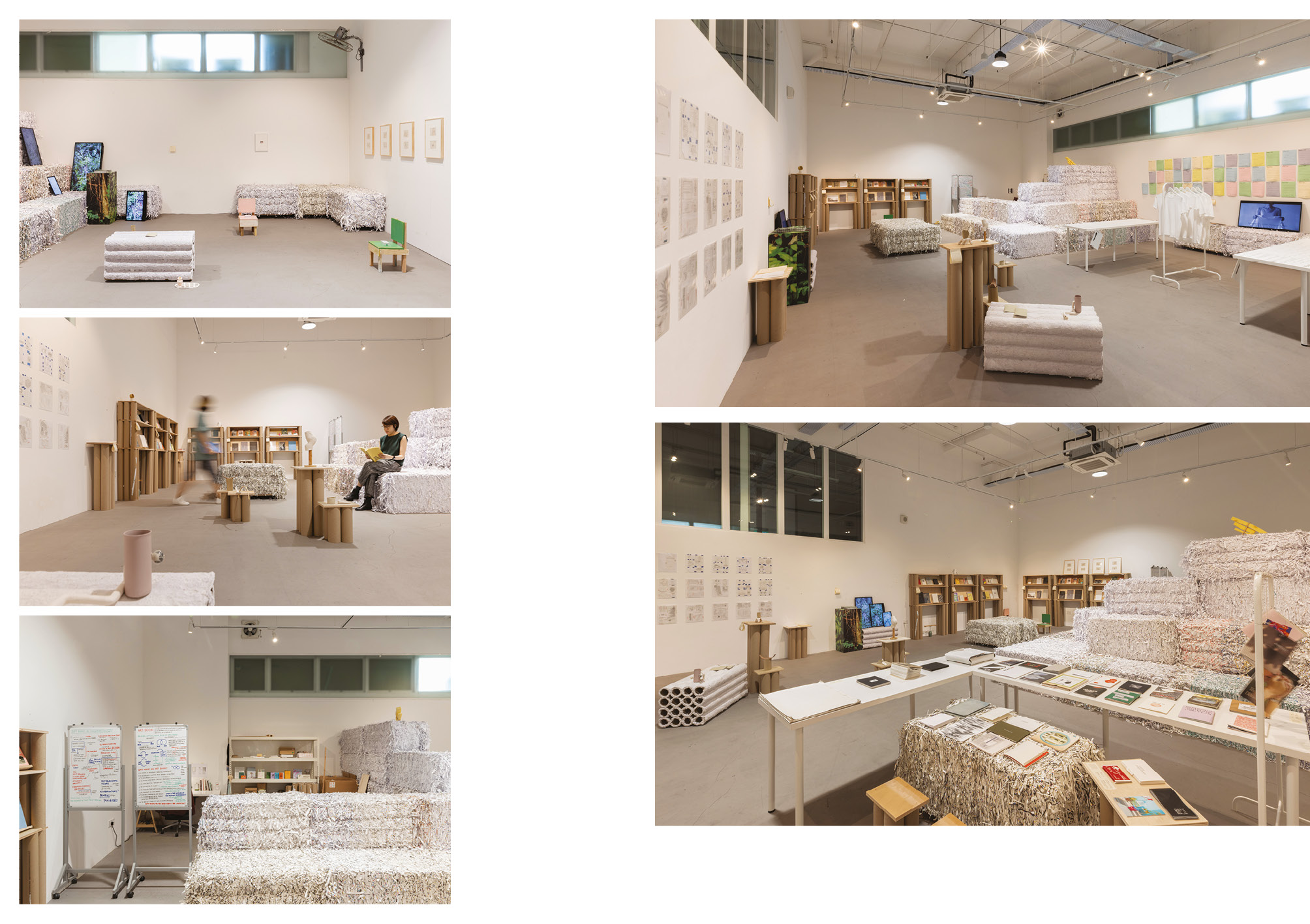
Berny Tan, Page Break, 2022-23.
Curatorial and research residency at SAM Residencies. Installation view at Singapore Biennale 2022 Natasha, Singapore Art
Museum at Tanjong Pagar Distripark. Photo: Marvin Tang. Courtesy the artist.
Sung Tieu
Sung Tieu (b. 1987, Vietnam) lives and works in Berlin, Germany and London, UK. Tieu’s work takes place at the intersection of her personal experiences, global history, and the cultural incursions of European art traditions. Her immersive installations result from her research of the dynamics of hegemonic globalised capitalism, working through and with spatial dislocation while paying heed to the cultural testimony of the Vietnamese diaspora communities in Germany. Through the personal lens of post-colonial identity and cultural membership, she upsets the status of objective narrative and of proof when science works at the service of sociopolitical agendas. While addressing social and cultural class divides in both contemporaneity and recent history, Tieu’s work foregrounds the ways evidence is manipulated in imperialist violence, both of physical and psychological nature.
Loveless
Inside the 18th century decor of the gallery, two dining table units designed for custodial environments have been installed. Across their stainless-steel surfaces empty food containers have been left, suggesting they have been recently used. Ambient sound hovers in the room. Composed of field recordings and audio libraries, the noise of kitchen alarms, gates slamming and neon lights flickering have been built in to a single dissonant rhythm that eventually transitions into a melody. Images move across a stainless-steel encased TV screen. The images, like the field recordings, are observational. Through sound and a newspaper clipping specific spatial locations are invoked while the melodies leave an undercurrent of a personal memory. This is contrasted by the sculptural elements that adjure a blank expression of global universalism for the audience to engage with.
Parkstück
Parkstück is the third in a trilogy of exhibitions each comprised of two artworks: Loveless and Formative Years on Dearth (both 2019). Formative Years on Dearth saw Tieu collect, stage and reinterpret a selection of materials from an extensive research of the John Latham Archive. Tieu creates a visual essay by interweaving histories of John Lathams personal life with her own memories. This intuitive personal account used Latham’s voice to entangle the private and the personal with global social and financial narratives.

Sung Tieu, Loveless, 2019.
Installation view, Loveless, Piper Keys, London, UK, 26 January–24 February 2019
Courtesy the artist; Piper Keys, London; and Emalin, London. Photo: Mark Blower
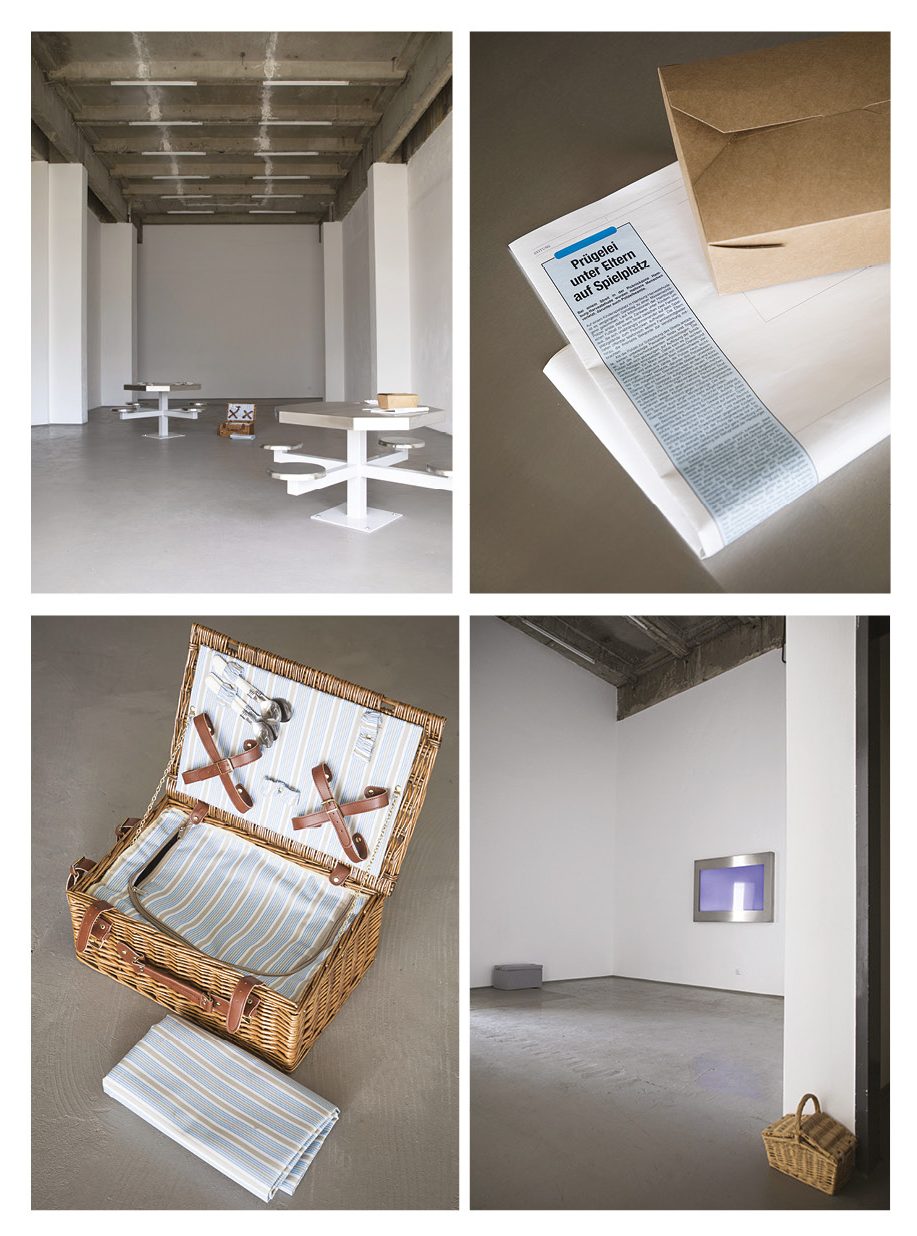
Sung Tieu, Loveless, 2019.
Installation view, Parkstück, Fragile, Berlin, Germany, 01–28 June 2019.
Courtesy the artist, Fragile, Berlin, and Emalin, London.
Trevor Yeung
Trevor Yeung (b. 1988, China) uses botanic ecology, horticulture, aquarium systems and installations as metaphors that reference the emancipation of everyday aspirations towards human relationships. Yeung draws inspiration from intimate and personal experiences, culminating in works that range from image-based works to large-scale installations. Obsessed with structures, he creates different scales of systems which allow him to exert control upon living beings, including plants, animals, as well as spectators.
Mr. Cuddles Under the Eave
Mr. Cuddles Under the Eave is a large-scale installation composed of 13 uprooted pachira aquatica (also widely known as money trees) suspended from the ceiling on an eight– by eight–metre metallic grid. Each tree is leashed onto the hanging structure with ratchet straps tied through the crevices of the tree’s braided branches. The trees are dangled without order, some hanging diagonally and hori-zontally, whilst others are suspended vertically.
The trees are imprisoned to the ruthless harness of ratchet straps, being subjected to a condition of immobility. Standing beneath the installation, one cannot help but feel an imminent menace, weary that the trees may collapse at any moment. The state of restraints embodied in Mr. Cuddles mirrors the lockdowns of the last few years. The interdependency between people during isolation is not unlike the branches of the money trees, which are actually multiple plants woven together during growth; they are fated and without escape. These leashed trees personify a collective anxiety, power-lessness and fragility.
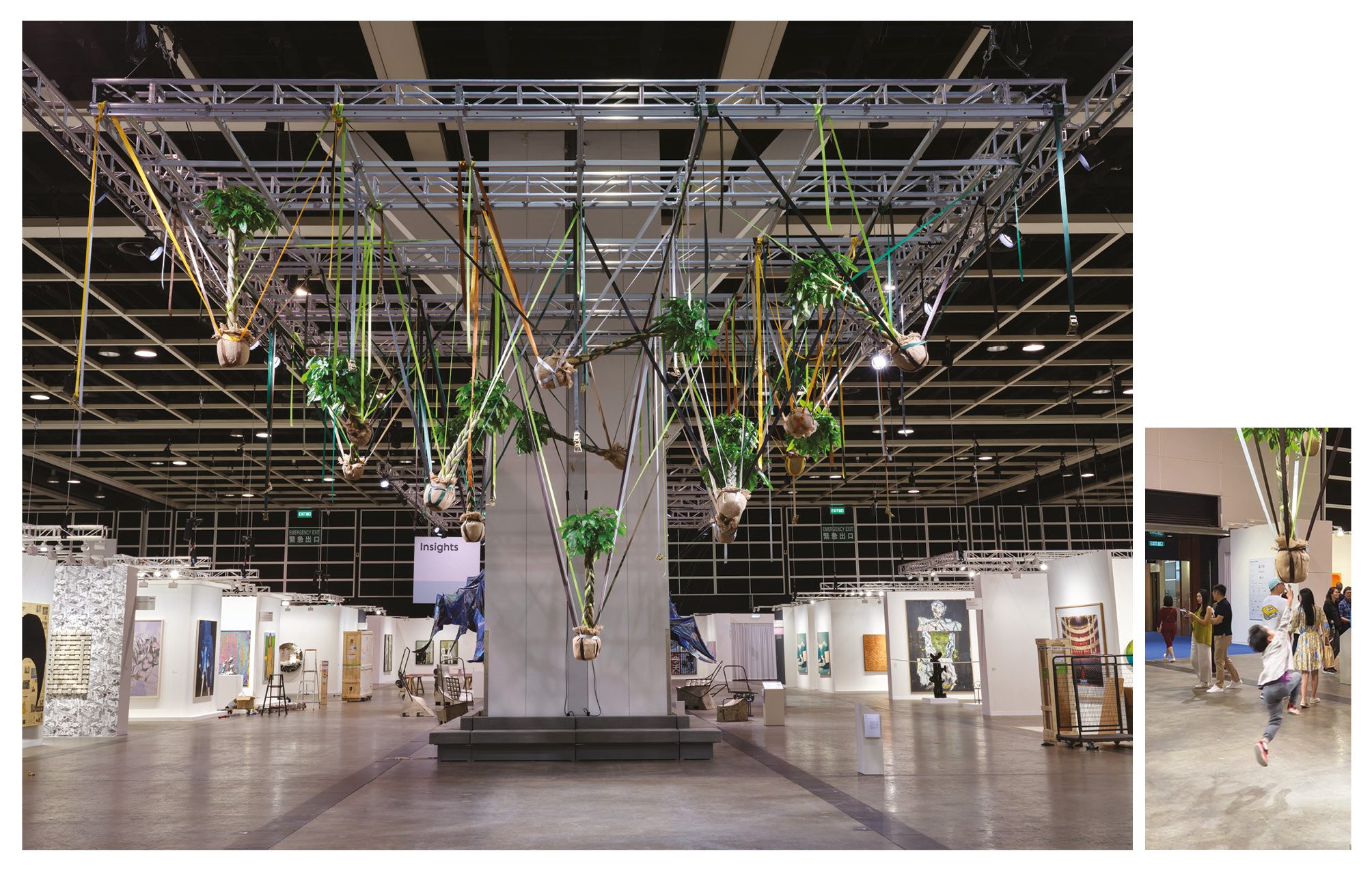
Trevor Yeung, Mr. Cuddles Under the Eave, 2021.
Pachira trees, straps. Dimensions variable. Installation view Art Basel Hong Kong 2023. Photo: South Ho.
Courtesy the artist and Blindspot Gallery.

